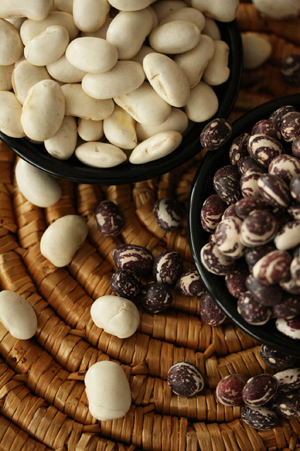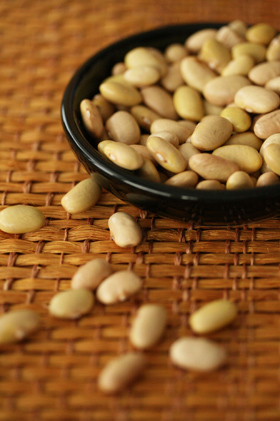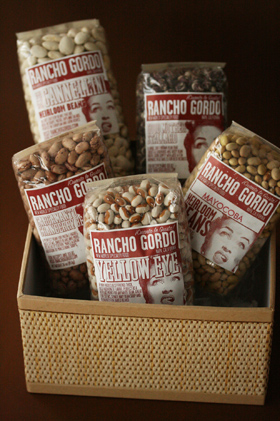 |

 |
Heirloom beans: the familiar cannellini bean and the unusual Good Mother Stallard bean. Heirloom cannellini beans have a much richer taste than supermarket varieties. All photography by River Soma | THE NIBBLE. |
| WHAT IT IS: Gourmet beans grown from heirloom strains. |
| WHY IT’S DIFFERENT: Freshness, softness and flavor over “starchiness.” |
WHY WE LOVE IT: Beauty, variety and tasty fun. |
| WHERE TO BUY IT: RanchoGordo.com. |
|
|
 |
 Page 3: Rancho Gordo Heirloom Beans Page 3: Rancho Gordo Heirloom Beans
Rancho Gordo Overview
The Rancho Gordo heirloom bean business was born some 13 years ago, after founder Stephen Sondo ate a Rio Zape. An heirloom pinto bean from Mexico, its depth of flavor shocked Sondo. This was no ordinary pinto bean.
Sondo’s bean epiphany engendered some research, which in turn revealed hundreds of heirloom beans waiting to be discovered—and saved from extinction—in Mexico, Central America and South America alone. He wanted to save these great beans from disappearing for good, “so I started growing them,” says Sondo.
“My thinking [was that] the best way to save these beans is by eating them and letting people see that...they are more than worth the bother.”
Now that we’ve “bothered” to try them, we can’t imagine ever buying another supermarket bean.
What is an “heirloom” bean?
According to USDA standards, heirloom plants are grown from seeds that have been passed down for more than 50 years (preceding modern agribusiness, which has bred every food product for maximum output and other characteristics over flavor and aroma). Heirloom growing also requires open pollination. This means that in addition to sowing, the seeds are able to disperse naturally via birds, insects, rain and wind (unlike man-made hybrids).
The yields are low and the shapes aren’t as uniform as industrial beans, but tasting is believing. And buying these rare beans helps to support genetic diversity.
The article continues below with bean varieties.
|
INDEX OF REVIEW
This is Page 3 of a four-page review. Click on the black links below to visit other pages:
|
MORE TO DISCOVER
|
Rancho Gordo Heirloom Beans
Rancho Gordo beans are grown in limited quantities to ensure quality. Small crops enable freshness—the grower doesn’t have to store excess supplies of beans.
Supermarket beans can be five years old or more, and totally devoid of moisture. They need an overnight soaking. Freshly-harvested artisan beans still have natural moisture, and may require just two hours of soaking. Too much soaking will cause them to split when cooked.
Rancho Gordo grows up to 30 varieties at any one time, but as the seasons wear on, favorites run out. In fact, it’s been three months since our beans arrived to this writing, and only one of the five beans we tried are still in stock! As the inventory changes, we won’t go through every bean; but here’s a sample of what’s in store for you:
- Ayocote Negro Beans. The Aztecs enjoyed these beautiful, meaty beans. Large, shiny and black with white “eyes,” they are tasty and chic.
- Rio Zape Beans. The beans that started it all, these handsome beans are a deep rose-purple with black markings and white eyes. Like a velvety pinto bean with flavor nuances of coffee and chocolate, they make a memorable side dish or chili.
- Snowcap Beans. These snow-white beans with burgundy markings have a silky texture and a potato-like flavor. Make bean soup from them, and be sure to save some cooked whole beans for garnish.
- Yellow Eye Beans. The artisan alternative to Navy beans (a.k.a. Yankee beans) and Great Northern beans. Skip the slightly gummy, baby food texture of Navys and Great Northerns, and opt for the dense, creamy and delicious Yellow Eyes (see photo). Make Navy bean soup or add a ham hock for a flavorful side.
|
 |

Mayocaba Beans: creamy and dense. |
- Yellow Indian Woman Beans. Whether it’s the name, the beautiful golden color or small size, this bean attracts the most interest at farmers markets. The bean is creamy like a black (turtle) bean.
Head to cooking tips and recipes on the next page.
— Karen Hochman
RANCHO GORDO HEIRLOOM BEANS
20-30 Varieties That Vary By Season
- 16-Ounce Package
$4.95
A Few Varieties Are $5.95
- Samplers
Four Or Five Different Varieties
$23.80 To $25.75
- Deluxe Gift Box
5 16-Ounce Bags of Heirloom Beans
1 Autographed Copy of the book Heirloom
Beans
1 Cloth Logo Tote Bag
$51.99
Purchase online* at RanchoGordo.com
*Prices and product availability are verified at publication but are subject to change. Shipping is additional. These items are offered by a third party and THE NIBBLE has no relationship with them.
|
 |

Sleek packaging makes Rancho Gordo beans a fun house gift or stocking stuffer. |
Continue To Page 4: Bean Recipes
Do you have friends who would enjoy THE NIBBLE?
Click here to send them an invitation to sign up for their own copy. |
© Copyright 2004-2025 Lifestyle Direct, Inc. All rights
reserved. All information contained herein is subject to change at any time
without notice. All details must be directly confirmed with manufacturers, service
establishments and other third parties. The material in this e-zine may not
be reproduced, distributed, transmitted, cached, or otherwise used, except with
the prior written permission of Lifestyle Direct, Inc.
|
|

|
 |